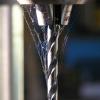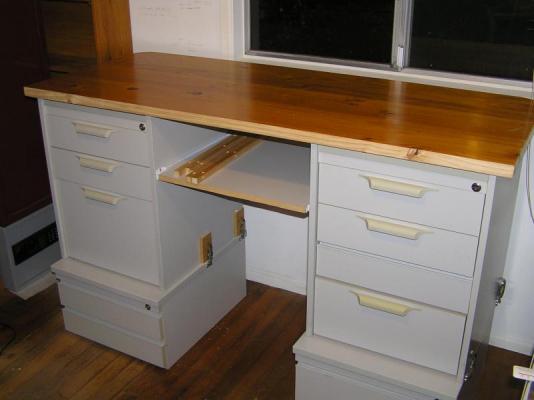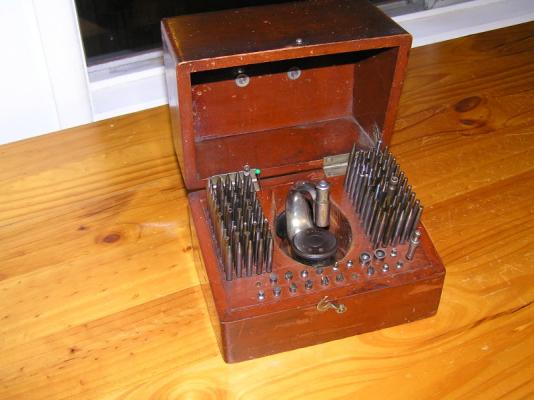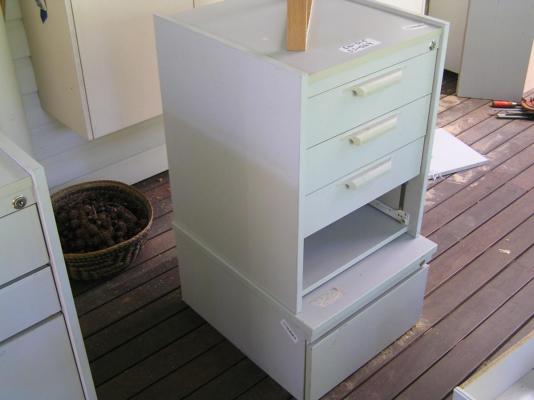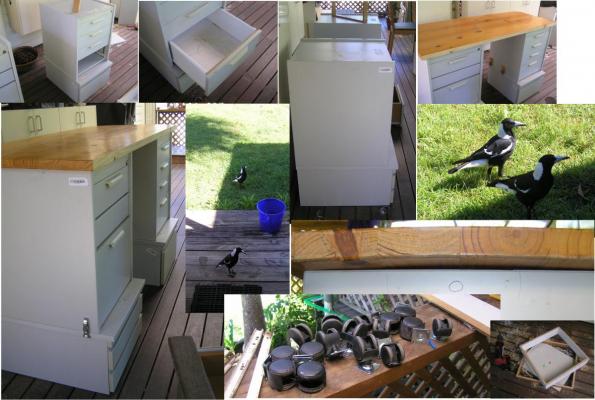Leaderboard
Popular Content
Showing content with the highest reputation on 04/10/15 in all areas
-
Almost done. I've test assembled it on the veranda - the workbench is heavy as if made of lead. Good that I got it all in modules. Moved the bench inside and here it is: While inside I added little shelf (for clocks and writing) the I can roll out. Just that there is no mistake it will be used for watches and clocks (the staking set just took possession of the bench).. So tomorrow I will try to install some fences on the bench top - back and sides - and on the shelf. I am quite happy with the result. Next a decent light. Z ps. I should have more pictures taken in the process to properly report the job and to give some workbench making ideas for others.2 points
-
Just finished servicing one of these as part of a task set by my Horology tutor. Thought I wold give a quick walk through as it is an interesting and very good movement that can be had fairly cheaply. The Bidynator was the first Bi-Directional auto movement (Felsa 690) introduced I believe in the 1940's. This is the later 1560 calibre. Here is the rotor that is removed by moving the tiny spring loaded lever down and left to unlock it. This is indicated on the rotor by a small arrow. With the rotor removed the auto plate is revealed. You can also see it has Incabloc shock protection and the escape wheel has capped jewels. Auto plate removed revealing the bi-directional auto module. This movement has 2 clicks, the one on the auto module does not let the power down. The click to let down the power is located at the 2 o'clock position in this picture resting against the barrel ;) With the plate removed the gear train is exposed, notice the twin gears on the third wheel. The lower wheel is slightly offset to the top wheel. These engage with the (indirect drive) centre seconds pinion to prevent stutter I guess? I didn't photo inside the barrel when I took it apart but it has a conventional mainspring hooking, but there is a separate slipping bridle that runs around the inside rim of the barrel. The mainspring hooking, hooks on to this and this provides the slipping mainspring that is required for a automatic movement. The slipping bridle is removed during cleaning and braking grease apple to the barrel wall before re-assembly. NOTE: The mainspring winds in reverse to the more common mainsprings (ETA's etc) This caused a problem with my mainspring winder that can only wind in one direction (Bergeon..Hah!) So it was hand wound in which was quite straight forward. When the gear train has been removed there is a final bridge holding the centre wheel in place. Flipping over the movement reveals a straight forward motion works and keyless setup. Again you see the capped jewel escapement and look at that shock setting, this is a well made, good quality movement ;) Lubricants used were, Auto module and rotor 9010 Gear train D5 & 9010, 9415 on the pallets Mainspring wiped with D5, Barrel wall 8213 braking grease Keyless and motion works D5 & Molykote DX The movement is performing very well with a 48hr power reserve. I don't have a timegrapher at home so regulated it with a digital stopwatch as close as I could. It is still within a minute, 3 days later, being worn all day on the wrist...Impressive. Here's the completed watch.1 point
-
Greetings to you all from the north of sweden!! Here you have another watch fanatic, and I don't want to miss this opportunity and introduce myself to the forum. Daniel is the name and I'm not a watchrepair man by trade, just an advanced nerd so far.. :geek: ..! I've just finished a service on an old front-mounted Cimier military watch with very good results. My ambition is that one day being able to service my latest addition to the small collection... My "new" Omega 176.0012 Speedmaster IV, or 4,5 as some people call them. This is a 40th year present which I have treated myself with. According to the serial, 39xxxxxx, the watch is exactly as old as me, manufactured in the year 1975. This makes it a really early one. The timepiece is in fantastic condition, original glass with no chips and almost no dents on the casing whatsoever. The case is really nice refurbished with the classic sundial pattern and the polished corners and so on. I've fitted a new stem with the "real" crown (st 43238) and have also bought the right omega bracelet(1162-172) for this watch. I'm also very proud to have the original 70s box, very hard to come by in this good condition. The original insert for the box is missing though, so a pillow will have to suffice for the moment. But as you can see in the pictures, the original bracelet is only mounted where it sits in the box. The bracelet which I have fitted now is a really nice, thick, sturdy and heavy bracelet which I found on a website. I understand why they have a thicker bracelet on the new retromodel of the mark II. A thicker bracelet really completes the the bulky 70s style casing and really gives the omega a great prescence on your wrist. As you can see my bracelet also has tapered links and polished sides that lines perfectly with the style on the case. The purist in me just wishes that it was an original omega bracelet... Anyway, this is me and my new best friend... Many thanks to Mark for your absolutely great videos, they really inspire me for my future projects. And ofcourse this already great forum, you've started something really good here, keep it up! :woohoo-jumping-smiley-emoticon: (PS: maybe a service video on the lemania 5100/omega 1045 is something for the future..;-) ) :judge: Cheers to all of you other nerds in here! :thumbsu:1 point
-
Hi, I am new to these forums and recently retired from the lubricants industry and now enjoying my new hobby of messing about with watches etc! I see a lot of posts on all forums about lubricants and thought I may be able to help with the basics so giving members a better understanding. This is a very broad subject so I will try and cover in a series of posts relating to specific areas of lubrication. I will try and answer any questions but may defer if I will be covering them in a later post. Firstly 'What are the different types of lubricants?' We have fluids (oils), semi-solids (greases and gels); solids Oils can be mineral (hydrocarbon), vegetable, and animal. Other fluids are generally classed as chemicals or synthasised fluids. Mineral oils are most common nowadays for lubrication but in the past vegetable (olive oil, rapeseed oil etc) and animal (lard, sperm oil, neats foot oil etc) were widely used. Some vegetable and animal oils are still used in mineral oil blends, especially neats foot oil, to provide special properties such as added lubricity. Refined mineral oils are made from crude oil, the refining process removes many of the 'nasties' to give a range of 'base oils' . These base oils have an industry range of viscosities and are used as made or blended together to meet industry standard viscosity bands (ISO VG). To meet specific lubrications needs (hot, cold, high wear, EP, water ingress, cleaning etc etc) chemical and other additives are blended into the basic mineral oil. Sometimes additives are needed to counteract the effect of some of these additives !!). Synthetic Oils can be based on mineral oil or be chemical compounds. Strictly speaking synthetic mineral oils should be called synthesised mineral oil as they are made by re-combining hydrocarbon molecules to make bespoke mineral oils. These are much purer and have better inherent temp, lubricity and oxidation properties, they also need less additives to modify their shortcoming properties. Ordinary mineral oil has molecule chains (her comes the chemistry!!), short, medium and long. The shorter the molecule the more volatile (will evaporate quicker) and lower viscosity (thickness, runniness) it has. The long molecules leave sticky, gummy residues when aged. The additives help to reduce these effects but they will all happen in time, and so the oil 'goes off'. Loss of short molecules can lead to oil viscosity increases and degeneration of the long molecules can lead to oil tickening and gums forming. Synthetic mineral oils can be made to greatly reduce the amount of small and large molecules (called light and heavy ends), so a more stable oil results. Also the natural contaminents of a natural mineral oils (which require additives to control them) are not present. Synthetic Oils based on chemical compounds are also used as specialist lubricants because of their unique properties, but are unlikely to be used in watches etc, but may be used as an additive for very special applications. They can also be very aggressive to some materials especially rubbers, plastics and paints. I'll post about additives etc in another post. Greases can be thought of as a lubricant retained in a sponge. The sponge is what is know as the 'soap' and the lubricant can be any of the above 'oils' that are compatible with the soap. The soap type is again determined by the operating conditions and the degree of specialisation required. Modern trends are to replace soaps with gelling agents but these have a more limited scope of operating conditions. Solid lubricants are materials that generally plate-out onto the working surfaces and can be applied as they are or suspended in a fluid lubricant. Typical solid lubricants are graphite, molybdenum disulphide, PTFE etc. They can cause problems in very tight clearances as they may tend to close them up over time. That's it for now, plenty to ponder on. Hope I haven't bored you too much. I will carry on with more posts if feed back is posiitive.1 point
-
Seeing all those workplaces and benches here I decided to make one for myself. Budget, budget and budget. So... We have in Brisbane this 'Reverse Garbage Shop'. They get stuff from businesses, manufacturers and citizens. They sort it out, price and sell to the public - excellent idea. Schools and artists have feasts. I visited them few days ago and found four office cabinets kind of file cabinets with some draws. Made of MDF and cheap-board in very good condition. The only issue is they are VERY heavy. Got them home and started to fiddle with them, cut, drill saw etc. I had an old table top (glued pine) 1500 long and the top turned out to be just right for the bench. It all turns out to be a bit largish but I will have plenty of space for tools (tools to be) and parts. I reduced the height of a pair of the cabinets so I can stack them up to rise the sides of the workplace. Decided for 900mm - it just fits under the window. It is still work in progress but at least I can sleep well knowing that I will have workbench so I do not need to bite my finger nails and feel this overwhelming envy for those of you already having nice workbenches. ;) The collage is a bit messy as I generally am. Half way one side already cut. Lowering the draws, fitting bench. The table top got little twisted and I hope I can spring flat it with some larger screws. As you can see I am still liked by birds. These are Australian Magpies. You feed them once and from that day they will demand food every day and complain if you are late. Next whatever is left of the cabinets. Magpies sing nicely Z1 point
-
I found this while researching some Omega information. Not recommended for pensioners suffering from Watchitus! ;) https://m.youtube.com/watch?v=ZZQKjlcb8-o&t=231 point
-
1 point
-
Yeah, it is supposed to, it is a Fast Clock...identified by the guy on the dial...always running! :D I've told him not to push the minute hands but he never listens!1 point
-
That will be a great setup once you have finished it Zenon, lot's of storage space plus natural light from the window. :) When your up and running, you'd better keep the window closed or your feathered admirers might steal the shiny bits! ;)1 point
-
No shame at all Zenon. I've even repaired two of these beasties in the last year, how bad is that! It's what us old codgers do. B)1 point
-
Hi, Thought I'd move on a bit more and talk about What the Numbers Mean. Lubricants can be called anything they like, and with specialist lubes the number in a grade name can have no meaning at all except for distinguishing one lube from another in a range. My old company used to have a register and we just took the next number in that for the grade name untill it was fully commercialised and then some even kept that number! Most industrial lubes now follow the ISO VG nomenclature, which is a 'brand name' followed by the 'ISO VG viscosity', eg Canthus 46 would be grade name Canthus with viscosity at 40 degC of 46 centistokes (cSt). Using this method at least the oil thickness/runniness can be compared, if not the other properties. The 'brand name' can often identify what type of lubricant it is (ie hydrailic, EP gear, turbine etc) and its major additives and performance levels. So what is viscosity ? This is a measure of the shearability or runniness of an oil and can be considered as the ability to forma lubrication film and/or flow through a bearing. There are several ways to measure it (ie measuring shear forces for dynamic visc and flow through an orifice for kinetic visc) but the most common units are poise/centiposie (dynamic) and stokes/centistokes (kinetic). The latter is the former multilied by the specific gravity (SG) of the oil. For most mineral oils this is about 0.85-0.95 and for SHC oil about 0.95-1.05, so for the degree of error involved, centipoise can be considered near enough to be centistokes when comparing oil viscosity (the purist will argue otherwise but at the user level it hardly matters). You may also see older units of viscosity such as Redwood, Saybolt etc. There are conversion charts for these (and now websites) but as they are measured using different temperatures, they need to be treated with care so they are compared at the same temps. The ISO VG viscosity has a small viscosity range either side of the number. The main numbers are 5, 10, 15, 22, 32, 46, 68, 100, 150, 220, 320, 460, 680, 1000 and others higher, 77 is also used but is not a true ISO VG. But these are at 40decC which is bit hot for a watch in normal use! Therefore you often see the viscosity quoted for 20decC (more comfortable!). For very cold applications it can be quoted at 0degC. There is a chart called a Refutus Chart which allows known viscosity at 2 temps to be plotted and joined by a straight line, and so the viscosity at other temps can be determined. I have all these charts if anybody needs help, although there are some excellent websites for these conversions. The slope of this graph indicates the rate of change of viscosity with temp (oil will thicken as it cools and thin as it gets hotter). The number for this is the Viscosity Index (VI), the higher the better is the general rule. A normal oil will be about 90 and this can go to 350, SHC oils are normally 120-150 and the VI can be even higher with additives (VI Improvers). To compare oil viscosities I usually convert them all to ISO VG which helps me at least determine their relative fluidity, which is the major factor in selecting an oil for an application or replacement grade (on a finer point, I use replacement rather than equivalent, as all the properties are unlikely to be the same). Pour Point - is the temperature at which an oil ceases to be fluid (normally due to the natural waxes solidifying) and for normal mineral oils this can be from -5dec for a thick (high viscosity) oil to -20degc for a very thin (low viscosity) oil. SHC oils have much lower pour points as they do not have the same level of waxes present. Pour point depressants can be used to lower the pour point, and are more common in ordinary mineral oils. So relevent to watches as it may affect the drag in the gear trains, pivots and mainspring barrel/arbour. There are often many other 'numbers' quoted in an oils product data sheet (PDS), but whilst they are useful to know they rarely have much relevance to watch oils due to the small operating temp range of a wristwatch or standard clock. The following are a list of those I can remember:- Colour - the natural colour of the lubricant or the colour with dye added. Odour - speaks for itself, but old oil industry hands can tell you whats in it from the smell! Density - only if weight is an issue! Vapour Pressure - only relevent at very low pressures (ie in orbit!!) Ph - Acidity, more relevant where a combustion process is present, or when materials sensitive to acids are used (ie copper staining etc). Flash Point - the temp when a spark literally on the surface ignites the vapours, 1mm further away and it is very high temp. Either way irrelevant to watch oil. Evaporation Rate - measures weight loss over time at given temps, a means of assessing the amount of residues left. Not critical for watches but obviously the lower the rate the better! Similar effects to ageing of an oil. Solubility in water - some additives can be detrimental to non-solubilty which could lead to corrosion. Not too relevant for watches as most oils are formulated to not have these problems. More a problem with greases. Grease Penetration Number (NLGI) - normally 00, 0, 1, 2, 3. Measures how far a cone penetrates a grease surface at a given temp, and is a measure of its 'stiffness'. The higher the number the stiffer the grease. Too thick and it may not get into the lube pint, too thin and it is squeezed out without effect. Grease Drop Point - temp at which a grease with 'melt' enough to drip (do not confuse with oil leaching out). Quite high temps so not too relevent for watch grease unless for hot conditions. Point of interest - It is usually better to use a wax based product for corrosion protection than grease. Grease often contains high levels of water in manufacture and once the inhibitors are 'used-up' over time, corrosion sets in under the grease film (remember the old brake cables in cars!!). Sure you are all bored by now, so I'll stop. Next post I'll try and relate to products on the market and how they stack up specification wise (usage and case history elements not included!). Thanks for you perseverence.1 point


